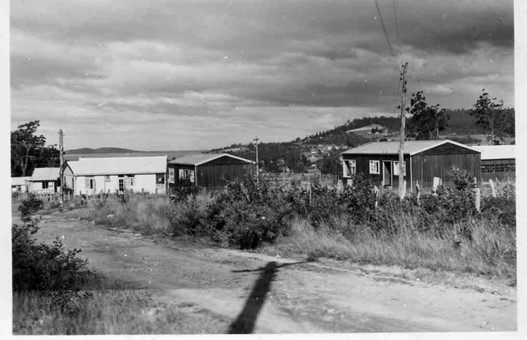This story is about how Little Groningen came to be.

The name was coined by the farmer, Geard, who sold the land to the “G7” scouts, van der Laan and Pinkster. (The “G7” was a group of 7 families who had decided to emigrate to Tasmania and establish a building company. One of the group was actually a builder).
On their first day in Kingston, Eerke van der Laan and Eb Pinkster were offered work on a house building site in Hutchins Street. There were other blocks in the street for sale, all priced at £110. Knowing that many more migrants were expected, all needing housing, and the tremendous housing shortage, they scouted for possibilities.
At the Presbyterian Church they connected with a Mrs Geard. Her husband offered to sell a 5 acre portion of his farm. The “G7” scouts calculated they could subdivide the land and make building lots available for £40. Although demands from the local Council were not high in 1950, they did have some say in the project. The extract below, from the Minutes of the Kingborough Council meeting of 11 September 1950, records the discussion.
Very little of this discussion involves subdivision or building rules and regulations. The extract is far more interesting for the record of local attitude to Dutch migrants. The paragraph in the minutes is headed:-

“Dutch Migrant Centre
Messrs EJ van der Laan and E Pinkster waited on the Council regarding their proposal to subdivide land at Kingston for a Dutch community, as their people would be coming out from Holland from time to time. The Warden welcomed the visitors to the district. Cr Shoobridge explained the position re the subdivision which he would like to see go ahead. The Guarantee for the construction of the road was a big obstacle. Mr van der Laan said he hoped the Council would approve the first 10 houses, and by that time the people could construct the road themselves to avoid a Bank Guarantee.Cr Shoobridge stressed the need of a water supply which would encourage further building, and other subdivisions. The migrants should be encouraged – some were on their way now, and an answer was required as speedily as possible. The Engineer should look into it forthwith. The Warden said it could not be decided in a hurry, as people at Blackman’s Bay had priority. It would be unwise to tell the deputation things that could not be carried out. Cr BJ Pearsall suggested that an electric pump be installed by the visitors and water drawn from Brown’s River. There was less pollution now than years ago when there was more cultivation. Cr Bylett said he appreciated the class of migrants that were coming – it was hoped to keep Australia white and we should do all we can to encourage the Dutch. Cr Crane said it was hoped that workers would come as there was need of them. The Dutch had a good name as workers. He could place several families on his property later on towards Christmas.Cr Watson said the Council should go ahead with the scheme. Cr Pryde said they were all agreed it was desirable but it was a matter of Blackman’s Bay and Margate Road first, and then the pipes and extra water supply for this project. Cr B Pearsall said the water from the creek could be used for building purposes. Cr Shoobridge said it would be 4 or 5 months before pipes were available. The Warden said he would not make any rash promises but would do everything possible in the matter. The visitors, in retiring, said they appreciated the welcome and hoped they would prove to be good citizens and work to develop the country.

It was move by Cr Shoobridge, seconded by Cr B Pearsall, that Mr Maclean have control of temporary building permits for the Dutch community. Carried.”
Some years later, the road leading from Browns Road to the migrant settlement was changed from Old Summerleas Road to Groningen Road.
(ref: Wierenga, K, Dutch Migration to Tasmania in 1950: Motivation, Intention and Assimilation, thesis, 2005 Hobart, University of Tasmania).

